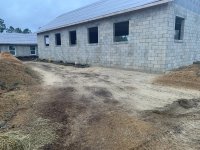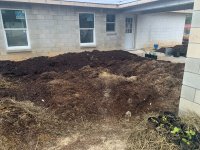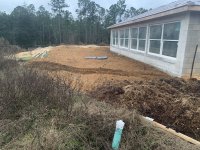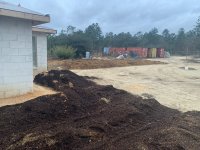1930
Platinum Member
- Joined
- Sep 9, 2018
- Messages
- 925
- Location
- Brandon/Ocala Florida
- Tractor
- Kubota B6100E Kubota L 2501 Kubota T1460
Help me to decide
Try to keep short
Foundation is 18 thick, dug down and removed approx 10 inches of sugar sand.
We get large amounts of horse manure dropped off free throughout the week, regardless of what google or scientists say we have had very positive results, ( we literally have thousands of plants growing on another property using the stuff that will one day come over here ) ( and we are feeding at least 1000 here on this property)
Pure sugar sand, very low nutrient levels in itself ( it’s been tested )
We’ve been placing this manure/shavings/hay mix around the house by the bucket full.
If we lay it about 20 + inches thick we figure in a couple/ few years we will end up with 4-5 inches of premium soil.
We look at the forest around us and note the pine tree’s that have been there hundreds of years with thick ( 4 inches ) compost at their base but under that pure white sugar sand.
We don’t understand why the soil isn’t dark rich under these tree’s?
You’d think after that many years the soil would be black?
We are considering purchasing a tiller to mix the sand and our compost together into the ground.
Then we consider that tillers are meant to break up hard compacted soil for root development, we have loose sandy soil.
Yes it can get pretty darn compact under the top surface but it’s still just sand, no rocks.
Are we wasting our time and money on a tiller?
Our ultimate goal is to have a garden to supplement food and also to enjoy healthy trees/plants on the property.
Thanks to all the farmers
Try to keep short
Foundation is 18 thick, dug down and removed approx 10 inches of sugar sand.
We get large amounts of horse manure dropped off free throughout the week, regardless of what google or scientists say we have had very positive results, ( we literally have thousands of plants growing on another property using the stuff that will one day come over here ) ( and we are feeding at least 1000 here on this property)
Pure sugar sand, very low nutrient levels in itself ( it’s been tested )
We’ve been placing this manure/shavings/hay mix around the house by the bucket full.
If we lay it about 20 + inches thick we figure in a couple/ few years we will end up with 4-5 inches of premium soil.
We look at the forest around us and note the pine tree’s that have been there hundreds of years with thick ( 4 inches ) compost at their base but under that pure white sugar sand.
We don’t understand why the soil isn’t dark rich under these tree’s?
You’d think after that many years the soil would be black?
We are considering purchasing a tiller to mix the sand and our compost together into the ground.
Then we consider that tillers are meant to break up hard compacted soil for root development, we have loose sandy soil.
Yes it can get pretty darn compact under the top surface but it’s still just sand, no rocks.
Are we wasting our time and money on a tiller?
Our ultimate goal is to have a garden to supplement food and also to enjoy healthy trees/plants on the property.
Thanks to all the farmers
Attachments
Last edited:




